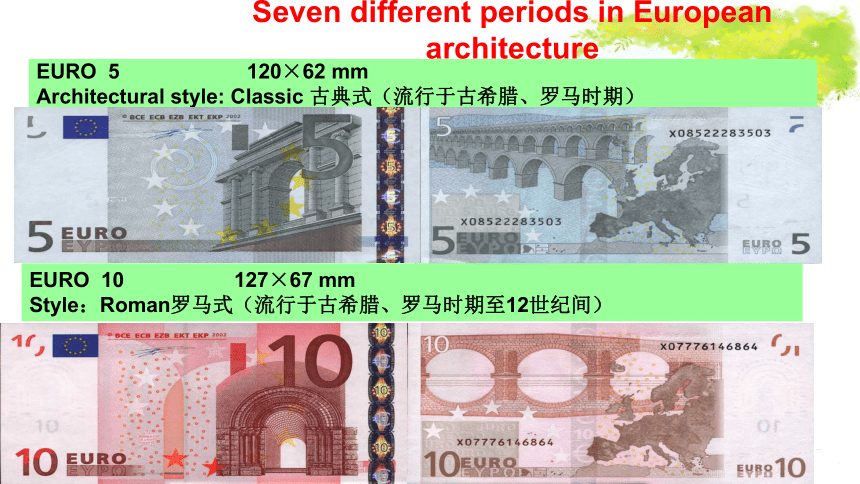模块4 Unit 10 Money Culture Corner 课件(共18张幻灯片)
文档属性
| 名称 | 模块4 Unit 10 Money Culture Corner 课件(共18张幻灯片) |  | |
| 格式 | zip | ||
| 文件大小 | 1.8MB | ||
| 资源类型 | 教案 | ||
| 版本资源 | 北师大版 | ||
| 科目 | 英语 | ||
| 更新时间 | 2019-07-09 07:12:10 | ||
图片预览







文档简介
课件18张PPT。北京师范大学出版社 Unit 10 Money
Culture Corner
Unit10 Money-Culture CornerThe Euro- the Second Biggest Currency in the world Unit 10
Culture Corner.mp3
Fronts and BacksFronts(正面)
Windows or gates
Of the ArchitectureBacks(反面)
BridgesThe design of the fronts of the notesWindows and gates represent ?the spirit of opening and cooperation in Europe.The design of the backs of the notesBridges symbolize the communication between the people of Europe.Seven different periods in European architectureEURO 5 120×62 mm
Architectural style: Classic 古典式(流行于古希腊、罗马时期)EURO 10 127×67 mm
Style:Roman罗马式(流行于古希腊、罗马时期至12世纪间)EURO 20 133×72 mm
Style:Gothic哥德式(流行于12—16世纪间)EURO 50 140×77 mm
Style:Renaissance文艺复兴式(流行于14—16世纪间)EUR 100 147×82 mm
主题风格: baroque巴洛克及洛可可式(流行于17—18世纪间)EUR 200 153×82 mm
主题风格: steel and glass 19世纪铁器及玻璃时代EUR 500 160×82 mm
主题风格: the 20th century modern building 20世纪现代建筑The euro coins The front side of all the euro coins are the same, which is called “common side”, marked the face value of them. The back side of the coins are designed by each country.
The euro coins have eight kinds of face value(1,2,5,10,20,50cent;1,2euro). Different coins can be used in different countries.
Spain has three designs: King Juan Carlos Ⅰ’s head, the Santiago church and famous writer Cervantes widening images .Germany has 3 kinds of pattern: 1 euro cents, 2 euro cents and 5 euro cents are divided into oak branches; 10 euro cents, 20 euro cents and 50 euro cents are divided into the Brandenburg gate; 1 euro and 2 euros for the eagle .1. When did the European Union start using the new euro?
On 1st January 2002
2. Who designed the euro?
Robert Kalina, Austria
3. Did the designer use the real existing structures? If not, what did he use?
No, he used photographs to make up imaginary structures that best represented the different architectural styles.
4. Why did the designer use gates or bridges in the euro?
This is to represent communication between the people.
5. How did European Union design the euro coins?
Each country was allowed to design their own coins which could be used in any participating countries
of Europe.
Answer these questions:Para1
Para2
Para3
Para4
Para5Match the main idea with each paragraph. The design of the coins.
B. The euro became the second biggest currency in the world after 2002.
C. The design of the notes.
D. When introducing the euro, European Union need to consider the design of the coins and the notes.
E. All euro notes show the European flag and a map of Europe.Summary In 2002, ______European countries started to use euro as their _________ (office) currency. But ___________(introduce) the euro is a big problem. Because 12 different countries were____________. They are_________ to put their own ______ and ____________ on the coins and notes. Later, Robert Kalina _______________ a _____________ (solve) to the problem. He put seven imaginary structures from different__________ in European _________________on the notes. The windows or _______ on the front and _______ on the back represent______________(communicate) between people. There are European flag and a map of Europe on all euro ______(note). Each country can design their own euro _______, which could be used in any of the ______________countries.12officialintroducinginvolvedkeenimagessymbolsdevelopedsolutionperiodsarchitecturegatesbridgescommunicationnotescoinsparticipatingWhy did European Union use the single currency---euro? Eliminate(消除) the exchange-rate fluctuation(波动)
Increase price transparency (透明度)
Lower transaction(交易) cost
Increase trade cross borders
Increase cross-border employment
Keep financial market stability (稳定)
Lower interest rate (利率)
DiscussionHomeworkWrite a passage to introduce the design of the euro.
Culture Corner
Unit10 Money-Culture CornerThe Euro- the Second Biggest Currency in the world Unit 10
Culture Corner.mp3
Fronts and BacksFronts(正面)
Windows or gates
Of the ArchitectureBacks(反面)
BridgesThe design of the fronts of the notesWindows and gates represent ?the spirit of opening and cooperation in Europe.The design of the backs of the notesBridges symbolize the communication between the people of Europe.Seven different periods in European architectureEURO 5 120×62 mm
Architectural style: Classic 古典式(流行于古希腊、罗马时期)EURO 10 127×67 mm
Style:Roman罗马式(流行于古希腊、罗马时期至12世纪间)EURO 20 133×72 mm
Style:Gothic哥德式(流行于12—16世纪间)EURO 50 140×77 mm
Style:Renaissance文艺复兴式(流行于14—16世纪间)EUR 100 147×82 mm
主题风格: baroque巴洛克及洛可可式(流行于17—18世纪间)EUR 200 153×82 mm
主题风格: steel and glass 19世纪铁器及玻璃时代EUR 500 160×82 mm
主题风格: the 20th century modern building 20世纪现代建筑The euro coins The front side of all the euro coins are the same, which is called “common side”, marked the face value of them. The back side of the coins are designed by each country.
The euro coins have eight kinds of face value(1,2,5,10,20,50cent;1,2euro). Different coins can be used in different countries.
Spain has three designs: King Juan Carlos Ⅰ’s head, the Santiago church and famous writer Cervantes widening images .Germany has 3 kinds of pattern: 1 euro cents, 2 euro cents and 5 euro cents are divided into oak branches; 10 euro cents, 20 euro cents and 50 euro cents are divided into the Brandenburg gate; 1 euro and 2 euros for the eagle .1. When did the European Union start using the new euro?
On 1st January 2002
2. Who designed the euro?
Robert Kalina, Austria
3. Did the designer use the real existing structures? If not, what did he use?
No, he used photographs to make up imaginary structures that best represented the different architectural styles.
4. Why did the designer use gates or bridges in the euro?
This is to represent communication between the people.
5. How did European Union design the euro coins?
Each country was allowed to design their own coins which could be used in any participating countries
of Europe.
Answer these questions:Para1
Para2
Para3
Para4
Para5Match the main idea with each paragraph. The design of the coins.
B. The euro became the second biggest currency in the world after 2002.
C. The design of the notes.
D. When introducing the euro, European Union need to consider the design of the coins and the notes.
E. All euro notes show the European flag and a map of Europe.Summary In 2002, ______European countries started to use euro as their _________ (office) currency. But ___________(introduce) the euro is a big problem. Because 12 different countries were____________. They are_________ to put their own ______ and ____________ on the coins and notes. Later, Robert Kalina _______________ a _____________ (solve) to the problem. He put seven imaginary structures from different__________ in European _________________on the notes. The windows or _______ on the front and _______ on the back represent______________(communicate) between people. There are European flag and a map of Europe on all euro ______(note). Each country can design their own euro _______, which could be used in any of the ______________countries.12officialintroducinginvolvedkeenimagessymbolsdevelopedsolutionperiodsarchitecturegatesbridgescommunicationnotescoinsparticipatingWhy did European Union use the single currency---euro? Eliminate(消除) the exchange-rate fluctuation(波动)
Increase price transparency (透明度)
Lower transaction(交易) cost
Increase trade cross borders
Increase cross-border employment
Keep financial market stability (稳定)
Lower interest rate (利率)
DiscussionHomeworkWrite a passage to introduce the design of the euro.
